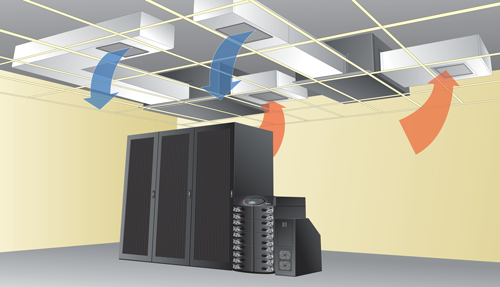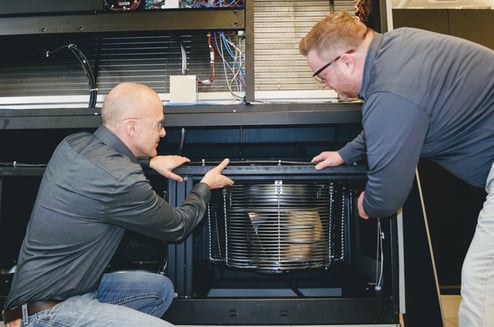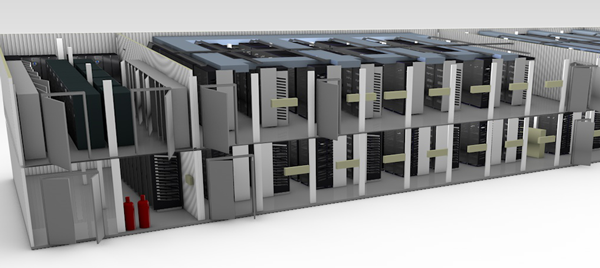The second in a series of posts that explores the vital signs of a healthcare system’s digital and physical infrastructure, this blog takes a closer look at the connectivity and reliability of your network’s central nervous system—the digital infrastructure responsible for ensuring healthcare continuity.
The reliability of critical infrastructure is arguably the most important vital sign when it comes to ensuring continuity in healthcare. Functioning much like the human body’s central nervous system, your IT infrastructure must continuously communicate with, monitor, and protect power and thermal management systems in order to stop downtime before it happens, and ensure that patient data and medical equipment are always available when and where they are needed.

As your healthcare system’s command and control center, your IT infrastructure is the link that connects medical staff with patient data. Its reliability is paramount as even a moment’s interruption could compromise so much.
Despite understanding the importance of improving network performance—a priority that is second only to ensuring data security and compliance, according to IDC’s 2019 Datacenter Operational Survey—downtime continues to be a big problem for data centers. Preventing downtime starts with creating a healthy and robust IT backbone, or central nervous system, that connects all components of your infrastructure.

Healthcare organizations can succeed in doing this three ways:
1. Upgrade and optimize your legacy data center.
451 Research’s Voice of the Enterprise 2019 Annual Data Center Survey shows that aging infrastructure and keeping up with infrastructure demands are the top critical infrastructure challenges for healthcare organizations. If you are looking for ways to optimize your legacy data center, it may be time to upgrade key components or invest in technologies or services that help you monitor and manage the health of your infrastructure. As you plan for these investments, keep these tips in mind:
- Consider investing in a recommissioning process to help you identify areas for efficiency improvement and upgrades that will bring your legacy data center up to meet today’s challenges.
- Integrate intelligent products and solutions where possible, increase visibility, access, and control; along with detecting and quickly correcting problems before they cause downtime.
- Look for future-proof, intelligent UPS systems that cover the backup power and power quality needs of your IT infrastructure. The best solutions will check five boxes:
-
- Intelligent (network connectivity and monitoring capabilities)
- Energy-efficient
- Reliable
- Modular
- Easy-to-maintain
- Choose thermal solutions that deliver the right cooling capacity while avoiding overcooling. Containment is another strategy that’s gaining traction, as it separates hot and cold airstreams to eliminate reconditioning the same air, thus boosting efficiency by 30% or more.

- Monitoring and data analysis. Monitoring systems such as Vertiv™ Environet™ allow you to keep tabs on power and cooling systems and environmental conditions
2. Build new flexible, scalable, and efficient data centers.
As delivery networks expand and emerging technologies increase loads, organizations need more space to manage IT. If it’s the right time to invest in a new data center, it’s the prime opportunity to make choices that will help future-proof your healthcare IT strategy, including:
- Select intelligent power, thermal management, and monitoring solutions as well as racks, power distribution, and enclosures. Set the stage for better visibility, control, and planning capabilities that improve performance throughout the lifecycle of your data center.
- Take advantage of prefabricated solutions that can save time and money while still allowing for customization and monitoring
- Standardize equipment from one vendor to reduce costs through increased buying power. It also streamlines buying processes, workflow procedures, training requirements, and often simplifies maintenance
- Invest in commissioning support. Commissioning can give you peace of mind that your new facility is designed, installed, tested, and maintained in ways that optimize performance throughout your data center’s lifecycle.

3. Ensure proper protection and management of assets housed in a colocation environment or the cloud.
According to the results of 451 Research’s Voice of the Enterprise survey, about two out of five healthcare organizations currently use cloud service providers, while just over a quarter rent space from a colocation provider. Most (70%) own and operate their own data centers. However, it’s entirely possible to protect and manage assets even when they are stored off-premise. Here are some strategies that can help:
- Critical features to look for include intelligent, energy-efficient power and cooling technologies along with DCIM software to monitor the entire facility, fault-tolerant designs for backup power and cooling solutions, proper equipment maintenance practices, on-site technicians, and a solid understanding of HIPAA compliance.
- Don’t make the mistake of relying on a ‘set it and forget it’ strategy. You can provide your cabinet equipped with features that improve security and efficiency, including biometric locks, smart PDUs that monitor power usage, and RFID technology that sends you alerts whenever an asset is accessed.
- Hybrid cloud solutions can provide a way to tap into extra capacity for some assets. A recent article by Hit Infrastructure speaks to this growing trend, which allows companies to store different types of data in different locations based on how much bandwidth is required, the sensitivity of the information, and how often it needs to be accessed.

Make sure your critical systems never miss a beat.
No matter where you choose to house your IT backbone, ensuring its health and viability is a must. With the right infrastructure solutions, you can create a powerful central nervous system that improves the connectivity and reliability of the digital infrastructure that powers your operations.
To learn more about protecting your IT backbone, contact DVL to discover how Vertiv solutions are helping more than 80% of U.S. healthcare systems achieve continuity for life. And be sure to stay tuned for our next post on growth at the healthcare edge.








